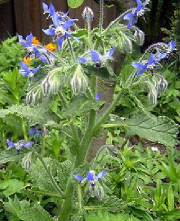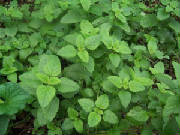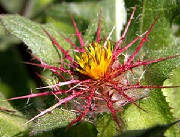|

The tender tops, young leaves, and flowers, are
sometimes used as a salad by the French, and boiled by the Italians. Medicinally it was formerly thought endowed with
very great virtues, and numbered among the four cordial flowers. The plant is not much used now except as an ingredient
in the drink called "a cool tankard," made of wine, water, lemon-juice, and sugar, to which a few of the tender
leaves seem to give additional coolness.
Balm
It has an aromatic taste, and a grateful fragrant
smell, a little like lemons. It is used in making balm-tea, a grateful drink in fevers, and for forming a pleasant beverage
called balm wine. The infusion promotes perspiration, and is thought good for complaints produced by a disordered nervous
system.

[Thomas Stuart McFarland, a farmer near Belgrade,
Newton County, in southeast Texas, reported that he had balm in his garden as of April 18, 1839.]
|
 |

Blessed Thistle
An infusion of the leaves is used as a stomachic,
to produce an appetite; if strong, it promotes perspiration. This plant had formerly a great reputation, but it is now
little used. The taste is very bitter and the smell disagreeable.
Bene
Introduced into this country by the negroes.
The seed are used for food in many parts of the world, and are also cultivated for the oil with which they abound. The
leaves abound in mucilage; one or two stirred in a pint of water, will form a bland mucilaginous drink very useful in cholera
infantum, dysentery and summer complaints generally.
|

